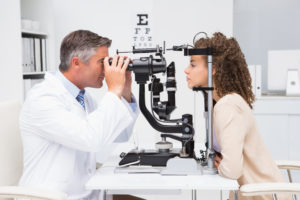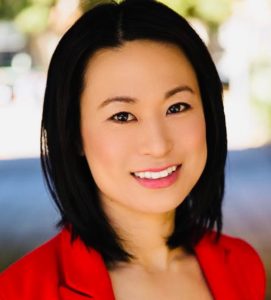sponsored content
March 15, 2022
Myopia is one of the greatest public health threats of the 21st century, and partnering together is how we can positively impact our patients.
 Monica Jong, PhD, BOptom, was recently appointed Global Director of Professional Education, Myopia, at Johnson & Johnson Vision. She was previously the Executive Director of the International Myopia Institute and led education and awareness initiatives to build consensus in the field of myopia management by bringing together leading researchers, clinicians, educators, and public health experts to develop evidence-based information for eye care practitioners, policy-makers, and educators. Dr. Jong recently sat down with John Sailer, Editor-in-Chief of Review of Myopia Management, for her first interview since joining Johnson & Johnson Vision to talk about the why, who, when, and how of myopia.
Monica Jong, PhD, BOptom, was recently appointed Global Director of Professional Education, Myopia, at Johnson & Johnson Vision. She was previously the Executive Director of the International Myopia Institute and led education and awareness initiatives to build consensus in the field of myopia management by bringing together leading researchers, clinicians, educators, and public health experts to develop evidence-based information for eye care practitioners, policy-makers, and educators. Dr. Jong recently sat down with John Sailer, Editor-in-Chief of Review of Myopia Management, for her first interview since joining Johnson & Johnson Vision to talk about the why, who, when, and how of myopia.
JOHN SAILER: What do you say if a patient/parent asks you why myopia matters?
MONICA JONG, PHD, BOPTOM: Often, practitioners have a very short time to engage patients and parents, so it’s crucial to have an ‘elevator pitch’ ready. For example, I might say, ‘Myopia is commonly thought of as nearsightedness, where objects further away are harder to see. In the past, we wore eyeglasses to help us see better, but myopia would usually keep increasing until we reached adulthood. Today, new research shows that we may slow myopia from getting worse with special treatments.1 This means that your spectacles might not be as thick long-term. Helping to slow down myopia may also reduce the risks of other potential eye problems down the road.’2 Tailoring the message to your individual patient/parent and keeping the message clear and simple is essential. Allow the patients and their parents to ask questions and follow up with patient literature to reinforce the message. At Johnson & Johnson Vision, we recognize patient communication is a key factor to being successful in myopia management, and we have been working with our behavioral scientists on Health Caring Conversations, which I’m really excited to share in the near future.
JS: Who should receive myopia management?
MJ: All children should be monitored for myopia,3 and any children at risk of myopia should be advised to go outdoors every day for at least 120 minutes with sun protection and reduce near work intensity.4 Every child who develops myopia of -0.50D or more should be offered myopia management.2
JS: There has been a lot of discussion about when practitioners should start managing myopia in children. Some prefer to wait for progression before they begin to manage myopia. What does the latest evidence suggest?
MJ: The evidence suggests that as soon as a child develops myopia of -0.50D (providing we rule out other causes), we should start myopia management. There is strong evidence that myopia will progress fastest in children younger than 12 and continue into the late teenage years, and 30% continue progressing into young adulthood. Age is the best indicator for the likelihood of progression, not previous progression.5 East Asian ethnicity, parental myopia, intense near work, and reduced time outdoors will further increase the risk.4 As Dr. Mark Bullimore says, every diopter matters as every diopter of myopia increases the risk of myopic macular degeneration by 67%.6 Modeling by different groups shows that applying treatment as soon as there is myopia onset can reduce the chance that they reach high myopia of -5.00D. At this point, the risks of ocular complications increase significantly.
JS: How often should practitioners be monitoring children undergoing treatment?
MJ: The International Myopia Institute recommends that the initial baseline comprehensive eye examination includes measuring best-corrected visual acuities, cycloplegic refraction, slit lamp, fundus examination, accommodation, and binocular vision assessment.7 Axial length monitoring is also essential, if available. Once the initial and aftercare appointments are complete, monitoring children every three to six months is recommended. Checking vision, axial length, change in myopia Rx, compliance, and response to treatment should be ongoing. It’s also an excellent opportunity to check in with our patients, and it allows us to be responsive. Reinforcing that our patients can contact us any time if they have questions is also important in building a trusting patient-doctor relationship, which is necessary for myopia management success.
JS: Do practitioners need an optical biometer to offer myopia management?
MJ: There has been a lot of new instrumentation and technology coming into this field, which makes it so exciting and improves our clinical decisions. You can get started in myopia management without an optical biometer. Refraction is highly correlated to axial length, and the clinical trials for optical treatments have demonstrated they effectively slow myopia progression. Optical biometry is very useful to track axial length change over time, informing where the child is relative to the risk of high myopia, so it’s a great diagnostic and communication tool. There are tables for the expected level of refraction and axial length for age available online8,9 that are helpful for patient management.
JS: There are a lot of treatment options available today. How should practitioners select a treatment?
MJ: Several evidence-based treatments are available, depending on where you live and practice. The final choice should be balanced against patient factors and treatment effectiveness because treatment efficacy varies with the age of initiation, treatment duration, and environmental and demographic factors. Choosing the most appropriate treatment for an individual requires us to understand the patient’s motivations and balance it with their risk factors, level of myopia, and vision and lifestyle needs, not just efficacy alone.
JS: How long should we manage a child with myopia, and does this differ for different treatments?
MJ: The current evidence supports managing children with myopia into the late teenage years, as myopia tends to stabilize by then. Careful monitoring is still vital for any potential adverse effects. Treating a child until their teenage years minimizes the likelihood of progression or any potential rebound effect.4 At this point, there is no evidence to suggest there is a need to taper off any of the treatments. If the child progresses again, you can re-treat. There is still a lot of work being done to understand when childhood myopia stops progressing, and on average, this seems to be around 16 years of age. The IMI 2021 white papers mentioned that 30% of cases of myopia developed after age 15.10 Having options for myopia management is important for the patient to suit their lifestyle and visual needs, which will change as they enter different stages of life.
JS: A lot of the studies are in children. Practitioners report that they see myopia progressing even in young adults of university age. Can we still offer myopia management to them?
MJ: Most clinical studies have been in children younger than 18 years. The mechanism of action of the optical treatments — reducing the defocus and providing myopic defocus, in other words bringing the retinal image forward in the peripheral retina to slow eye growth — is likely the same principles that apply to progressing myopia in young adults. But this is an area many of us are still trying to understand.
JS: Lastly, tell us about what you see moving forward from leading the International Myopia Institute to leading the myopia professional education initiatives globally at J&J Vision.
MJ: I recognize that these two groups are very different, the IMI being an expert group in myopia coming together to align the myopia evidence to drive awareness, education, and research in the form of key white papers, while Johnson & Johnson Vision is a health care company. However, the mission is shared, and there needs to be synergy between industry, researchers, and the eye care community to positively impact myopia. We have all the scientific evidence that treatments work, but professional education is vital for us to really change the trajectory of myopia. I’m excited to support eye care professionals by leading educational initiatives, including developing high-quality education to help shape the standard of care for myopia. Johnson & Johnson Vision has a record of delivering high-quality, practical professional education through its strong networks, which is critical because myopia management is ultimately hands-on.
Johnson & Johnson Vision’s mission is to first shape the standard of care through education and awareness about myopia and offer safe and effective treatments to address patient needs. Being able to contribute in the early stages by feeding back what practitioners are saying to the leaders at Johnson & Johnson Vision about myopia is a privilege and responsibility I take seriously. Professor Serge Resnikoff, the former head of the deafness and blindness prevention unit of the World Health Organization, acknowledged that “Change in legislation or regulations regarding the standard of care for myopia may be lengthy and difficult. But all eye care professionals (opticians, optometrists, and ophthalmologists) and the industry need to work together to combat myopia. This can be achieved faster than changing regulations.” Myopia is one of the greatest public health threats of the 21st century,11 and partnering together is how we can positively impact our patients.
JS: Thank you so much for chatting with us today.
MJ: My pleasure!
This article is sponsored by Johnson & Johnson Vision.
References
- Wildsoet CF, Chia A, Cho P, et al. IMI – Interventions Myopia Institute: Interventions for Controlling Myopia Onset and Progression Report. Investigative Ophthalmology & Visual Science. 2019;60(3):M106-M131.
- Brennan NA, Toubouti YM, Cheng X, Bullimore MA. Efficacy in myopia control. Progress in Retinal and Eye Research. 2021;83:no pagination.
- American Optometric Association Clinical Report Myopia Management- Developed by the Evidence Based Optometry Committee. 2021. https://aoa.uberflip.com/i/1388672-ebo-myopia-clinical-report-no-spread/0?
- Németh J, Tapasztó B, Aclimandos WA, et al. Update and guidance on management of myopia. European Society of Ophthalmology in cooperation with International Myopia Institute. Eur J Ophthalmol. 2021;31(3):853-883.
- Jones-Jordan LA, Sinnott LT, Chu RH, et al. Myopia Progression as a Function of Sex, Age, and Ethnicity. Investigative Ophthalmology & Visual Science. 2021;62(10):36-36.
- Bullimore MA, Brennan NA. Myopia Control: Why Each Diopter Matters. Optom Vis Sci. 2019;96(6):463-465.
- Gifford KL, Richdale K, Kang P, et al. IMI – Clinical Management Guidelines Report. Invest Ophthalmol Vis Sci 2019;60M184-203.
- Tideman JWL, Polling JR, Vingerling JR, et al. Axial length growth and the risk of developing myopia in European children. Acta Ophthalmol. 2018;96(3):301-309.
- Klaver C, Polling JR, Erasmus Myopia Research G. Myopia management in the Netherlands. Ophthalmic & Physiological Optics. 2020;40(2):230-240.
- Wolffsohn JS, Jong M, Smith EL, III, et al. IMI 2021 Reports and Digest – Reflections on the Implications for Clinical Practice. Investigative Ophthalmology & Visual Science. 2021;62(5):1-1.
- Holy C, Kulkarni K, Brennan NA. Predicting Costs and Disability from the Myopia Epidemic – A Worldwide Economic and Social Model. Investigative Ophthalmology & Visual Science. 2019;60(9):5466-5466.
PP2022OTH4141














